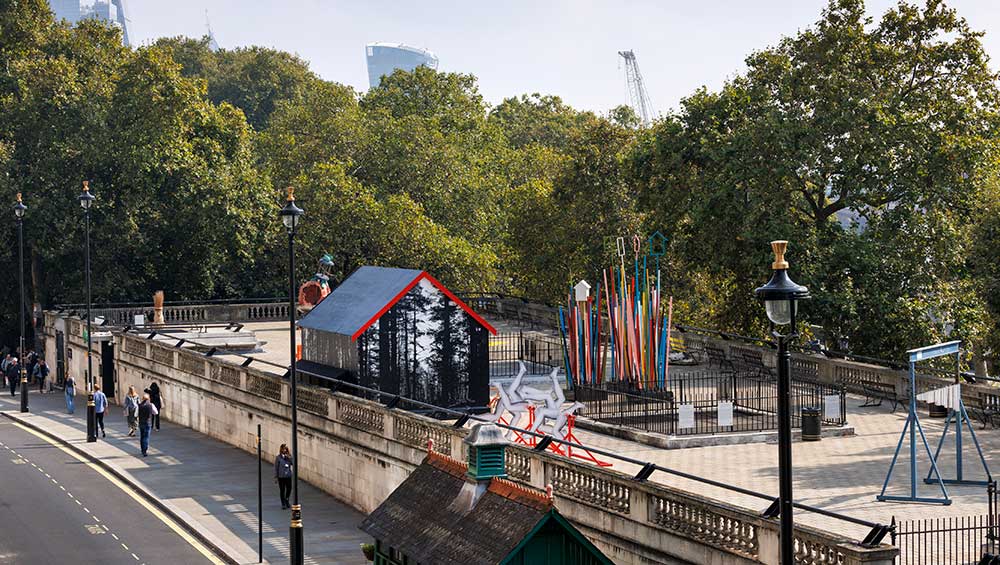
Mary Mary, Artist’s Garden, Temple Place, London. Image courtesy theCOLAB The Artist's Garden. Photo © Nick Turpin.
Artist’s Garden, Temple Place, London
3 October 2024 – 3 September 2025
by BETH WILLIAMSON
Mary Mary is a new exhibition from theCoLAB and the Artist’s Garden presenting public outdoor sculpture by nine female artists in the centre of London. However, the half-acre site does not seem to be a garden at all. Instead, it is a roof terrace on top of Temple tube station. From a historical perspective, the space is thought to occupy, at least in part, a 17th-century formal garden belonging to Lord and Lady Arundel that housed England’s first classical sculpture collection. There is, then, a logic to making use of the space in this way. Further, theCoLAB works to put art into the public realm, and specifically to provide a platform for the work of female artists. Again, there is a logic to the space and how it is being used. Even this exhibition’s title Mary Mary reconfigures the idea of certain women as contrary (as per the popular nursery rhyme). This is, in a sense, a reclamation of space by women. The physical outdoor urban landscape, often a threatening environment for women, is occupied by the work of these nine women. While female artists are still overlooked in arts histories, a great deal of work is being done to address those omissions and this exhibition is one instance of giving a voice to some of them, at least. It has to be said that the sculptures, dotted around the slabbed-over terrace, generally appear lost, or abandoned, in this rather shabby space. Yet, what can be said about the sculptures themselves?
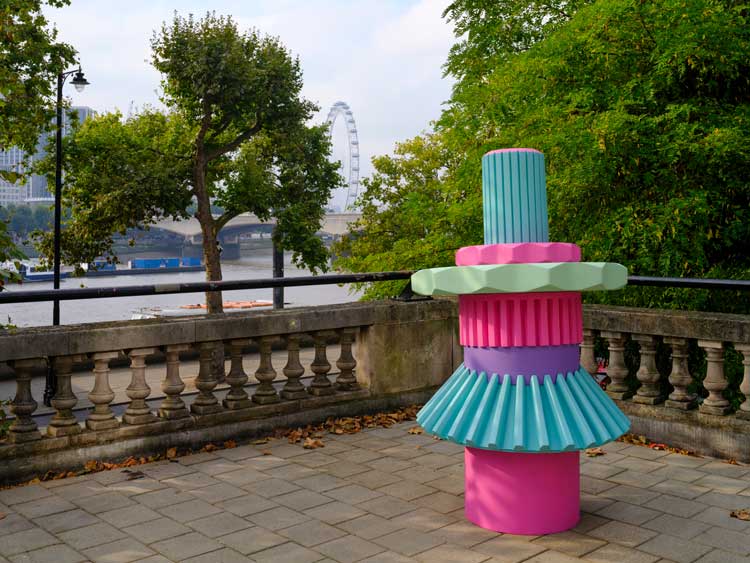
LR Vandy, Superhero Cog Woman #01, 2019. Installation view, Mary Mary, Artist’s Garden, Temple Place, London. Image courtesy theCOLAB The Artist's Garden. Photo © Nick Turpin.
The nine sculptures vary enormously in their style, strategy and effect. Inevitably, some work better than others. LR Vandy’s Superhero Cog-Woman (2019-24) is the first sculpture you encounter. It is bold and brash and stands as a tribute to women’s industriousness. Elsewhere, Vandy’s rope work Dancing in Time: The Ties that Bind Us (2024) celebrates the role Black women have played historically in building tradition and community. In Frances Richardson’s Performed Object fig. 09130123, Indolentia (2023), she transforms a neglected garden bench with unique materials to create a sculpture that can be performed.
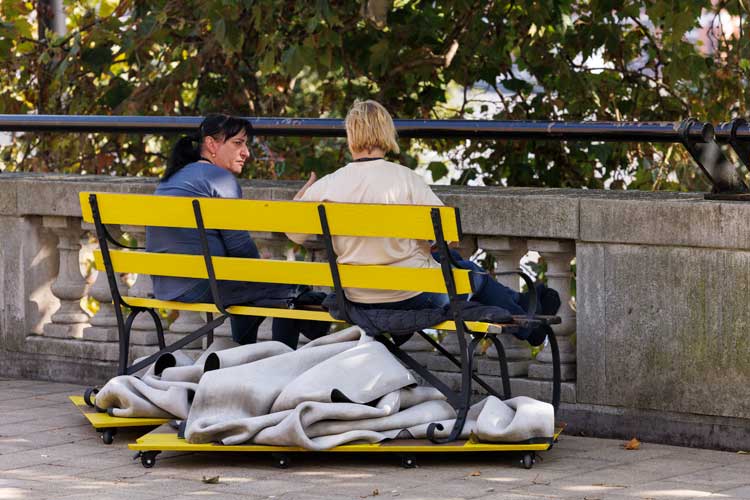
Frances Richardson, Performed object: fig. 09130123, Indolentia, 2023. Installation view, Mary Mary, Artist’s Garden, Temple Place, London. Image courtesy theCOLAB The Artist's Garden. Photo © Nick Turpin.
Rong Bao’s Yellow Path (2024) draws on the tactile paving used to guide the visually impaired around Beijing. Arranged in a square and containing a poem-work in braille, the sculpture activates an experience driven by touch and voice, rather than vision. Lucy Gregory presents It’s All Kicking Off (2024), an opportunity for the viewer to flex their muscles and activate the kinetic sculpture. Auguries Through the Mist (2024) by Candida Powell-Williams is a fountain, newly commissioned for the space and rather unruly in its subversions of classical garden architectural forms. In her work Savoy (2024), Alice Wilson presents a dense vertical forest of brightly coloured timbers with outlines of dwellings and other architectural elements at their tips. Next to Wilson’s Forest is the existing Artist’s Hut which she has wrapped in a photograph of a Scottish forest.
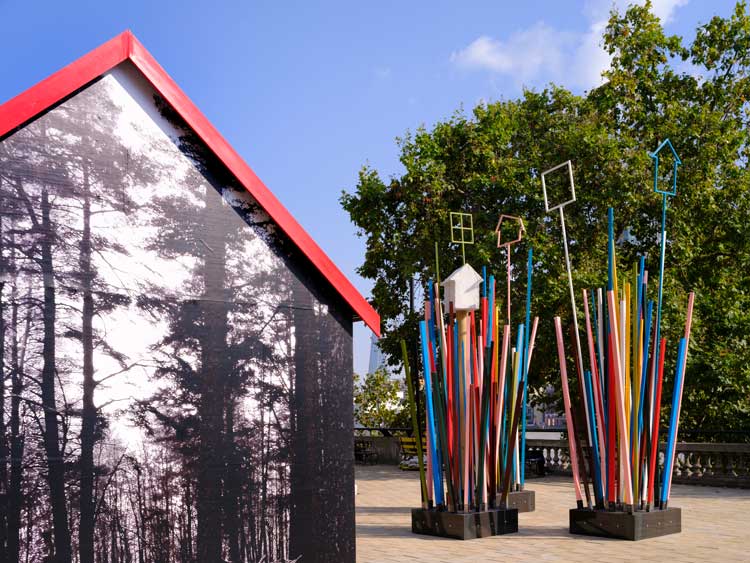
Alice Wilson, Savoy, 2024. Installation view, Mary Mary, Artist’s Garden, Temple Place, London. Image courtesy theCOLAB The Artist's Garden. Photo © Nick Turpin.
The intricate Another Mother (2022) by Holly Stevenson stands in for a lost baluster around the edge of the space. Stevenson’s thoughtful intervention performs a multitude of functions as it hides in plain sight. Most importantly, it stands as a testament to the life of Maria Kough, the wife of Joseph Bazalgette, the Victorian engineer who constructed the Embankment on which the Artist’s Garden sits. Kough was his unseen supporter and mother to his 11 children, each one represented by a flower on the sculpture.
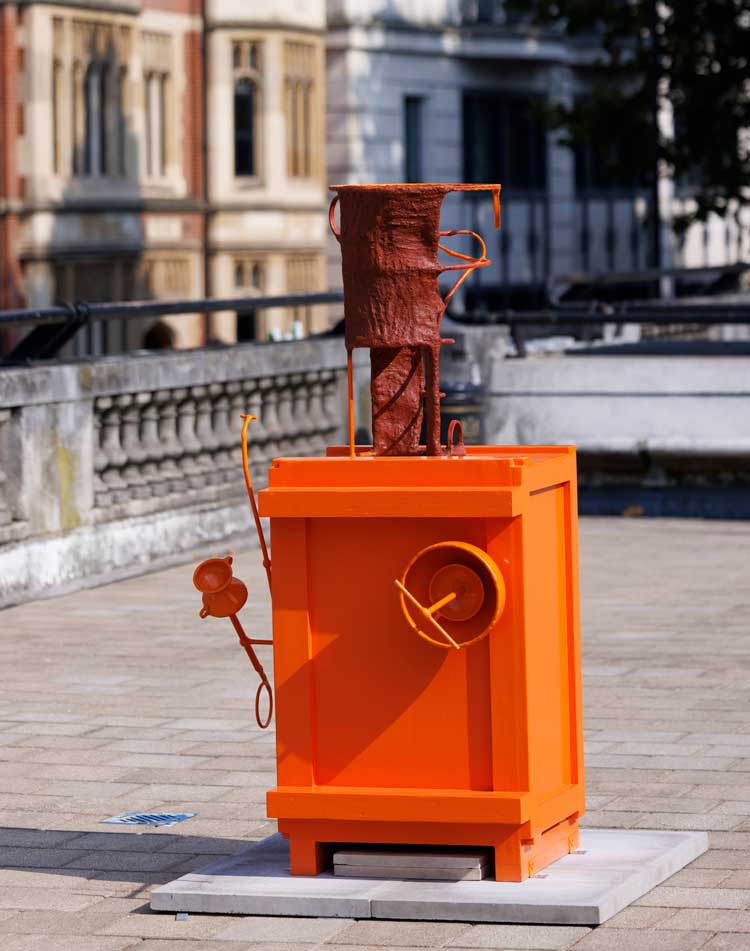
Olivia Bax, Cartouche, 2023. Installation view, Mary Mary, Artist’s Garden, Temple Place, London. Image courtesy theCOLAB The Artist's Garden. Photo © Nick Turpin.
Olivia Bax’s Cartouche (2023) and Virginia Overton’s Untitled (Chime for Caro) (2022) are, to my mind, the two most intelligent sculptures in this space. Bax’s sculpture brims with vitality, humour and a good dose of pragmatism. She made Cartouche when a commission for a Dutch sculpture park gave her a ridiculously small budget to work with. Cleverly looking for ways to work with the constraints that imposed, Bax shaved shipping costs by incorporating the crate in the sculpture. All other parts of the construction can be dismantled and shipped within the crate and unpacked and reassembled on site. The artist’s pragmatic solution also gestures to the work’s title, scrutinising the significance of containing, carrying and holding materials. The word itself – cartouche – means cartridge or container in French while in English it is a cookery term for a stewing, or a false lid. Bax’s Cartouche intends to work with all these possible meanings as she draws on illustrations of cartouches in Jacques Derrida’s book The Truth in Painting (1978).
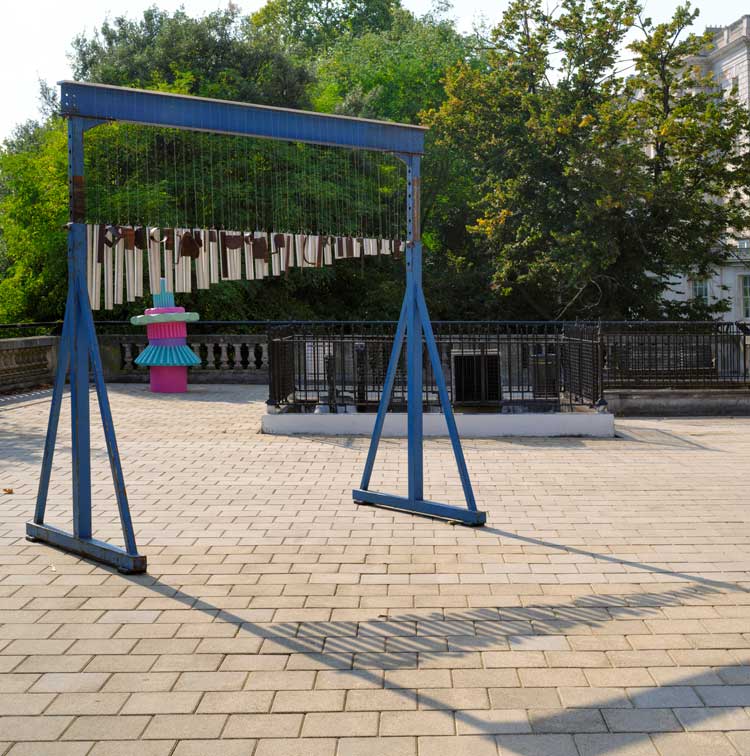
Virginia Overton, Untitled (chime for Caro), 2022. Installation view, Mary Mary, Artist’s Garden, Temple Place, London. Image courtesy theCOLAB The Artist's Garden. Photo © Nick Turpin.
Overton’s Untitled (Chime for Caro) (2022) is another kinetic sculpture, this time materially rooted in the history of British sculpture. She uses offcuts of steel that Anthony Caro deposited at Yorkshire Sculpture Park for use by other sculptors. Overton hangs these from an A-frame gantry, each remnant matched with a piece of hollow aluminium pipe of equal weight. Movement initiated by the wind or the viewer activates a conversation between the two materials. Overton’s intuitive and sensitive handling of materials in this way acknowledges her dialogue with other sculptors such as Caro while enabling her to work experimentally with the specific nature of materials as she finds them. Like Bax, her work also speaks to a formal investigation of sculpture and materials, which is perhaps what makes them so compelling. It is to their credit that these sculptures hold their own in a less than adequate setting. While it is billed as “the world’s first sculpture garden dedicated to the work of women artists”, you can’t help feeling those artists deserve better.